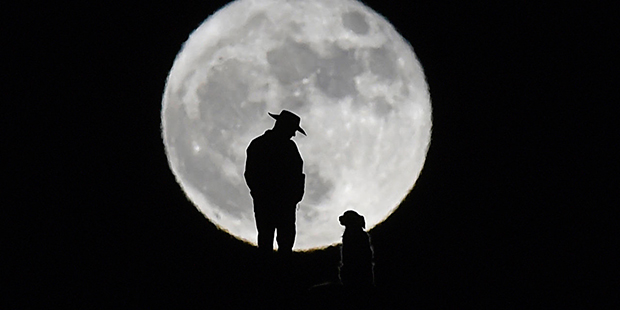December’s night skies will set great tone for 2017
Nov 29, 2016, 5:42 AM | Updated: Dec 6, 2016, 10:01 am

(Andy Barron/The Reno Gazette-Journal via AP)
(Andy Barron/The Reno Gazette-Journal via AP)
The skies are rich with signs and symbols of this great universe. You are a few moments from experiencing this for yourself by simply heading outdoors because December marks the two major sky events!
First, we get to see one of the year’s best meteor showers, the Geminids. It should peak on the night of Dec. 13, into the following morning.
Looking to the northeast sky around 11 p.m. to begin your Geminid watch. Under normal clear and moonless skies, you can expect to see upwards of 50 meteors per hour.
This year is different, as the full cold moon will spoil the show. However, all is NOT lost, as even under bright moonlight, you should still get to see a few bright fireballs.
The other main event is the wonder of the December full moon!
Coming on the backside of last month’s supermoon, the December full moon is also called the full cold moon. It will still be close to Earth when it rises about 5:06 p.m. on Dec. 13.
This moon is also known as the long night moon, as it takes the longest path across the ecliptic path, just like the sun does in summer!
The December moon begins as a thin, waxing moon. It will appear low in the southwest sky at sunset and reach the first quarter on Dec. 7. The moon is gibbous until it hits full on Dec. 13. The last quarter moon is on Dec. 20 and the waning crescent moon moves towards a new moon on Dec. 29.
Planets visible in December will shine bright too!
Look low in the southwest sky at sunset for brilliant Venus, which should be very bright. Saturn moves into conjunction with the sun on Dec. 10 and Mars will be visible and faint in the southwest sky at sunset.
The best planets to view in the morning sky would be Jupiter and a decent elongation of Mercury, before sunrise, in the southeast sky.
The annual winter solstice will occur on Dec. 21 at 4 a.m. local time as the sun reaches its lowest point on the ecliptic path.
Now, let’s look into 2017!
Next year will be another great one for observers looking for the usual — and unusual — sky events. The most important astronomical event for the public has to be the total solar eclipse of Aug. 21, 2017.
This is the first time that the deep umbra or central shadow of the moon will touch the mainland of the U.S. since Feb. 26, 1979.
The eclipse begins on the morning of Aug. 21. It will enter the shores of Oregon and move rapidly over Idaho and Wyoming. Then, the Midwest states get a taste of totality in Missouri and Illinois. From there, darkness will descend over a thin line in Tennessee and the Carolinas.
In order to see the true total portions of this eclipse, you need to be within the umbral shadow which will be some 73 miles wide at best. Some major cities that are NEAR, but not mainly in, this shadow are Casper, Wyoming; Kansas City, Missouri; Nashville, Tennessee; and Charleston, South Carolina.
The darkness will vary depending on your location, but some places may see nearly three minutes of shadow. You should make your plans now for this amazing event.
There will be some great opportunities to view planets and some great meteor showers in 2017.
Venus will be the major evening planet during the early portion of 2017. Jupiter and Saturn put on great performances during 2017 too.
Finally, the great meteor showers of 2017 — the Quadrantids in January, the Perseids in August, the Orionids in October, the Leonids in November and, finally, the Geminids in December — will all put on a good show!
Get set for a great 2017!
Happy holidays!
Get your own December sky map.








